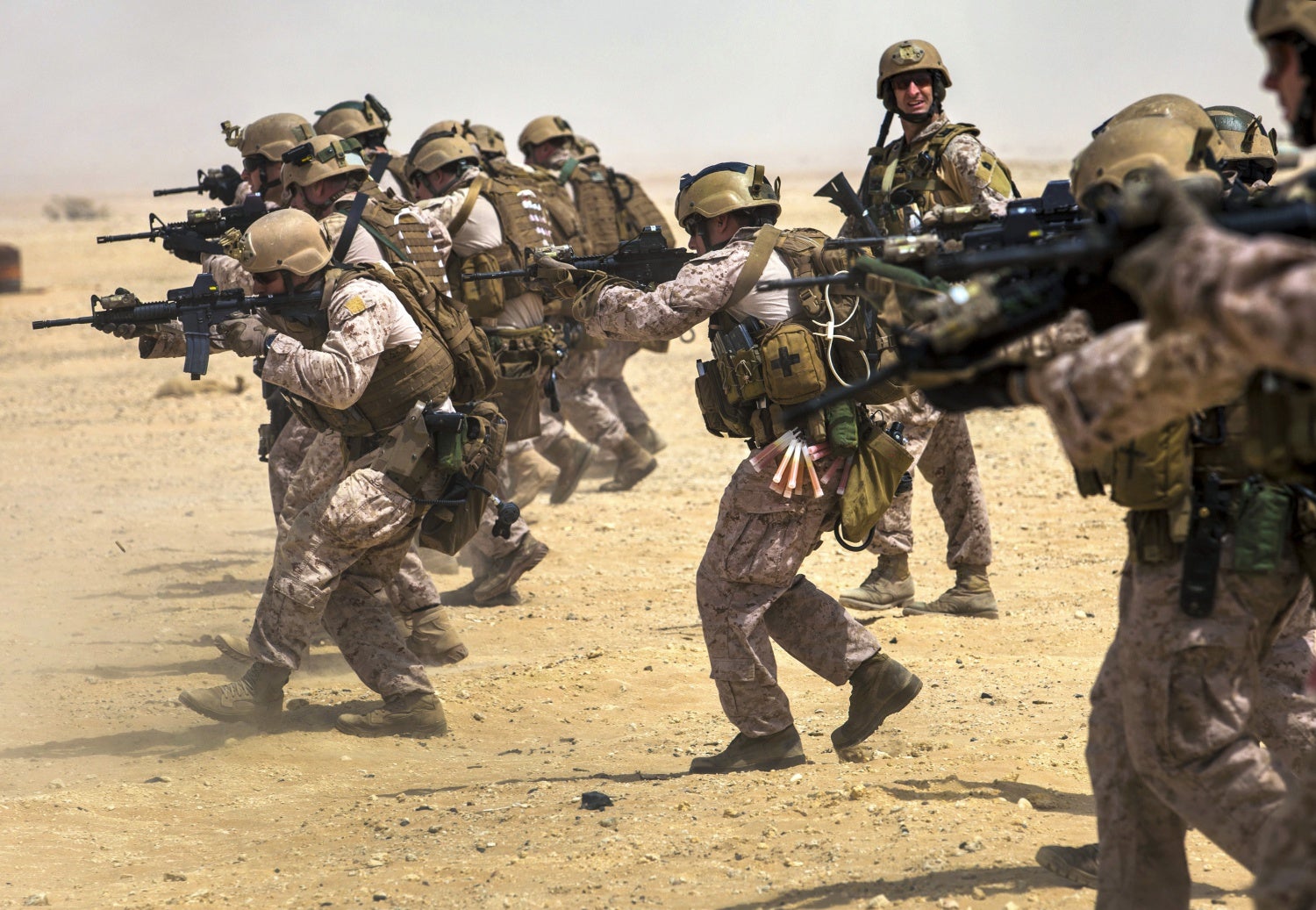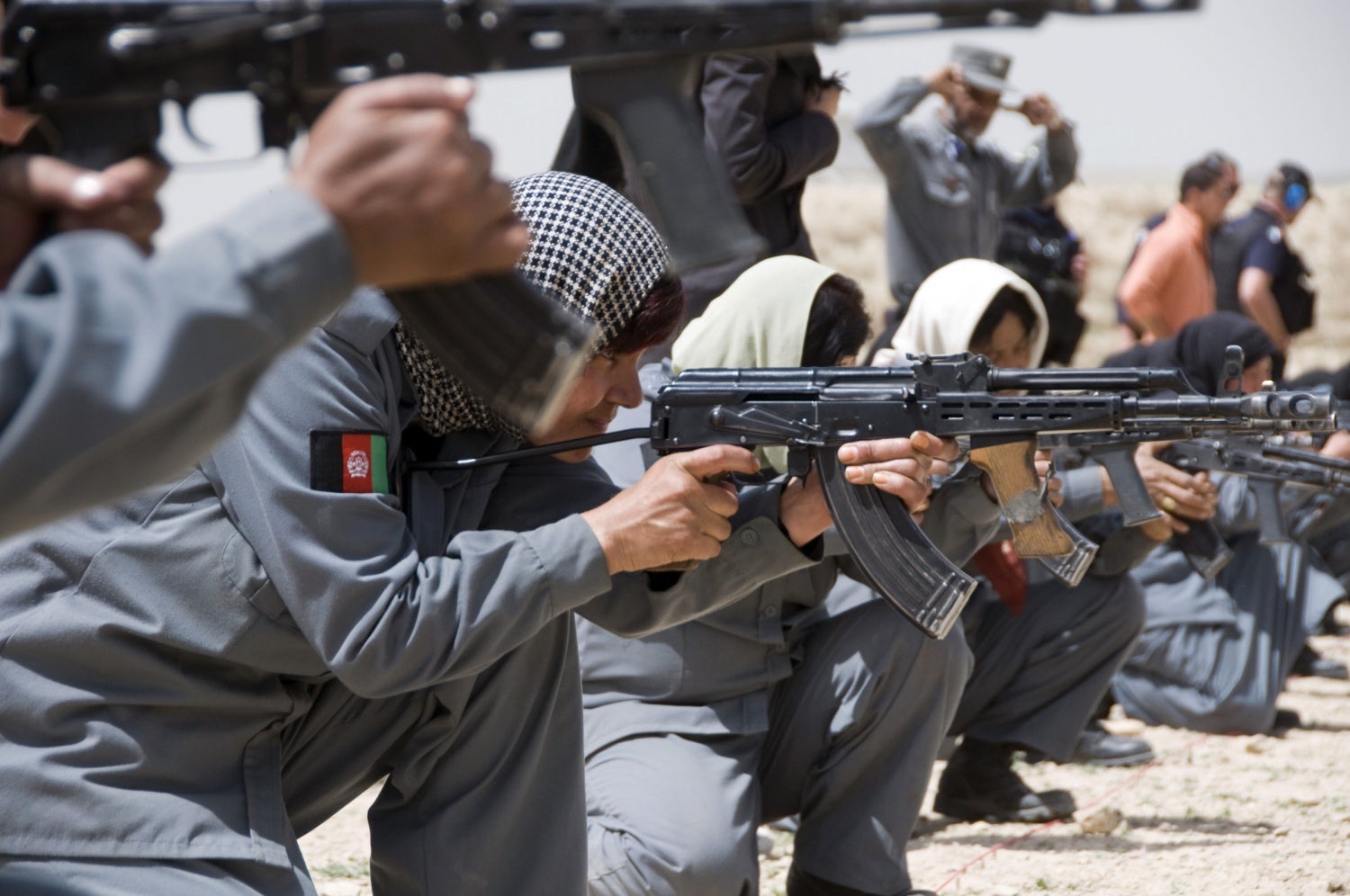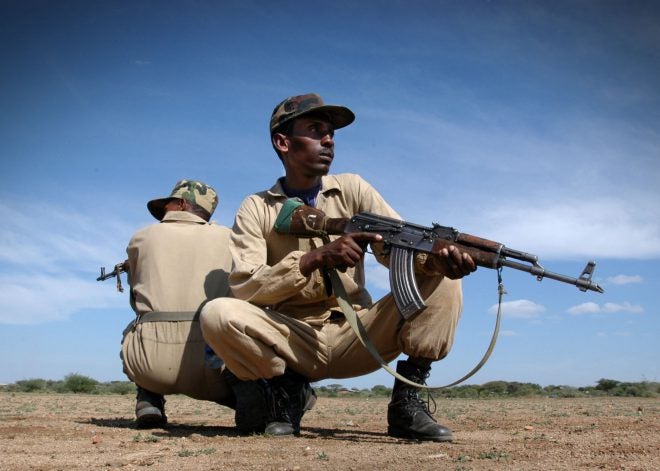Quick: What’s the definition of “assault rifle”? I’ll give you a moment to think about it.
Now, a good definition for “assault rifle” in my opinion comes from Anthony G. Williams, a British author, ammunition collector, and military theorist, and it reads like so:
A standard military rifle, capable of controlled, fully-automatic fire from the shoulder, with an effective range of at least 300 metres.
Williams has his own discussion of the meaning behind it, which you can read here, but I want to take a moment unpack this definition, and to provide my own corollary to it which I hope will add additional context. My aim in writing this is to provide a baseline understanding of what exactly a modern assault rifle is, and what its roles are (note the plural) in the modern infantry paradigm.
Now that I’ve said that, I already need to undermine it, just a little. Since the beginning of the Global War on Terror, there has been some modest ambiguity added to exactly what a standard infantry weapon is expected to do. Therefore, the discussion today will only address the paradigm as established in the period from 1945-2000, and not tackle the wider issue of how the role of the infantry rifle might be changing for the 21st Century.

Original caption: “DJIBOUTI–Sergeant Kris Floyd, chief coxswain with the Combined Joint Task Force – Horn of Africa Small Craft Detachment, fires the M-4 carbine weapons system during a two-day live-fire exercise here to improve weapons handling and marksmanship skills. The task force is here in support of Operation Enduring Freedom. Photo by: Corporal Paula M. Fitzgerald” The M4 Carbine is a variant of the M16 that was originally designed as a personal defense weapon, but which has since become a service rifle in its own right with both the United States Army and Marine Corps. Image source: commons.wikimedia.org
This is a good springboard for the rest of the discussion, because the story of the modern assault rifle really begins with the planning that began by the Allies at the conclusion of the Second World War. Although the assault rifle saw its prime time combat debut in that war, it was at the time just one type of weapon among many different, specialized types filling one or two roles each. While the Germans did consider and eventually embrace the idea of fielding MP.44 assault rifles as general issue weapons, the war was already effectively lost for them before it could be meaningfully implemented beyond some field trials of “MP platoons”. By the end of the war, the Germans had brought the assault rifle idea into the spotlight, but it was now up to the Allies to fully realize its potential.
Like the first, the second World War brought with it a tremendous advancement in weapons technology which threatened once again to out-pace the tactics and organization of the armies of the world. In particular, Allied armies found themselves troubled by a broad spread of specialized infantry weapons, each suited to a particular necessary task. This variety of weapons, besides complicating logistics, created a training bottleneck as troops could only be trained so quickly and thoroughly in the myriad of different weapons demanded by modern warfare. Training could cover all of the weapons very superficially, or only a few of them very thoroughly, not both. A 1948 report from Fabrique Nationale on the state of infantry weapons at the time, which can be found in part on page 24 of R. Blake Stevens’ UK and Commonwealth FALs (part two of the FAL series, and included in The FAL Rifle Classic Edition), states the problem thus:
Examining the armament of the infantry during the second World War, there is one outstanding fact – the number of different weapons which the unfortunate infantryman had to master. What were these weapons? The revolver for close quarter use, the machine carbine for street fighting and raids, the rifle for field work and the light machine gun for longer ranges and sustained fire power. The infantryman might also have to learn to use an automatic rifle, a sniper’s rifle, medium and heavy machine guns in ground and anti-aircraft roles. His spare time could be spent learning to handle anti-tank weapons, mortars, grenades, and grenade throwers. Regarded for generations as inferior in technical ability and only of use with a rifle and bayonet, the infantryman was suddenly faced with the need to master a greater variety of weapons than any other branch in the Army.
Could they be mastered by conscripts and men hurriedly trained in war time? The answer is certainly “no” despite a multiplicity of schools and instructors. The short time available before they must be sent into the battle line precludes anything but a superficial knowledge being acquired.
Since the 19th Century, the arms used by the infantry expanded dramatically as their tasks grew from simple marching and riflery to anti-tank, anti-pillbox, anti-trench, anti-aircraft, and numerous other duties. Some kind of solution was needed, and if it started with the weapons most integral to the infantryman, all the better. Many (though not all) planners at the time felt that the assault rifle idea was the perfect fit, as it could replace several of these weapons: The rifle, machine carbine (a British term for for the submachine gun), light machine gun, and in some cases the sniper rifle (designated marksman rifle). One change that had occurred over the previous 50 years that would help facilitate this simplification was the reduced effective range expected of the infantry. The FN report continues:
Modern military thought still demands that the infantry shall be able to develop a large volume of fire. There is, however, one important change in today’s ideas – the ranges at which the infantry is expected to engage the enemy effectively have been much reduced. No longer is the rifleman expected to shoot accurately at 600 meters, 300 meters is now his firing range, no longer are light machine guns expected to take on targets at 1,000 meters or more.
In these shortened ranges of 300 meters for the rifle and 600 meters for the light machine gun lies the hope of being able to replace two or more of the existing infantry weapons. There is one very important proviso – that a suitable cartridge be available or can be designed. The pistol type cartridges of the revolver and machine carbine are unsuitable for ranges above 100 meters, owing to their low muzzle velocity and poor accuracy beyond this range. The Rifle cartridge is too powerful and ranges too far though giving good accuracy and a flat trajectory – bot important considerations.
There is a middle course between these two extremes. The Germans towards the end of the war had achieved something that was very close to being the right answer, if not the answer. By cutting down their 7.92 rifle cartridge and fitting a lighter bullet they produced a short light round, which combined with a new weapon, gave their infantry a vastly increased ability to develop a large volume of fire for a much smaller man load. This question of ammunition is discussed later, but assuming the possibility of such a cartridge what is the effect on the weapons of the infantry?
A weapon can be designed round such a cartridge that will effectively replace the machine carbine and the magazine rifle, and render unnecessary the equipment of the platoons with light machine guns and/or automatic rifles. This still leaves the sniper’s rifle and revolver as infantry weapons. Both, though of minor importance, will still be needed, the sniper’s rifle for special targets and the revolver, or preferably the automatic pistol, for the use of personnel in back areas.
Here we see the origin of the post-war assault rifle in a need to streamline and simplify the Allied war machine according to the demands of then-modern wars of economy. Reducing the training burden on the soldier and at the same time the logistical burden of the army was seen as key to being able to wage this sort of conflict in the future. Note that the volume of fire added by universal issuance of automatic weapons gets only a mention in this segment of the analysis. Later, the document does address this matter:
In the light machine gun role it must be able to fire single shots and short bursts with reasonable accuracy up to 600 meters. Fitted with a bipod which can be carried in the pocket when not required, this standard of accuracy can be attained especially if a longer barrel is fitted. But in this role it should be capable of sustained fire. In this respect there is no question that it will do this as effectively as the modern light machine gun. If however the fire power of the platoon is considered then comparison is possible. The fire power of a platoon of 30 men is about 6-800 rounds per minute using its two light machine guns and rifles. A platoon armed entirely with the new weapons can develop under the same conditions a rate of 3-4,000 rounds per minute. This can be only for a short time, but if only one third of the weapons are firing then the effective fire power is roughly the same as the platoon with its two light machine guns and rifles. Thus by careful fire control, sustained fire can be maintained for some minutes without serious heating effects.”
It has already been stated that such a weapon cannot in sustained fire test approach the standard of the modern light machine gun. It can however be claimed that within the limits of the ammunition available in the infantry unit these new weapons can maintain the fire power of the platoon until such ammunition is exhausted. A higher performance is unnecessary.
It seems then that the primary benefit of the assault rifle in the eyes of this report’s author was not greater firepower for the infantry, but standardization, logistics, and ease of training. I don’t point this out to suggest that the firepower advantage of infantry armed almost solely with automatic weapons went completely unrecognized, but rather that the logistical and training problems faced at the time were considered so central that a discussion of assault rifles during the period could almost completely neglect the subject of firepower!

Original caption: “26th Marine Expeditionary Unit (MEU) Maritime Raid Force Marines fire M4 Carbines while conducting a marksmanship training exercise at a range in Qatar, April 22, 2013.” The M4 Carbine, like all assault rifles, is a versatile enough weapon to equip every member of an infantry squad. Image source: commons.wikimedia.org
So how does this context change our picture of the assault rifle? The first thing it should do is banish any individualistic perspectives about the concept that we may hold. Questions like “which weapon would you rather take into combat?” go wide and miss the true reason for the assault rifle’s ascendancy after 1945. It is clear that for the planners of the post-war era, that concern took a back seat to the more pressing matters of arming as many men as possible for the next unrestrained economic total war. From their perspective, what was needed was a jack of all trades weapon that could be made as cheaply and quickly as possible, and which – by its universal nature – would likewise allow troops to be trained in a manner much more expeditious than before. Note that even the famously anti-assault rifle American planners recognized the same issue, and they attempted to develop a full power weapon which could accomplish the same thing, resulting in the troubled M14. Indeed, it’s not an exaggeration to say that after World War II, the most pressing issue facing small arms planners was not one of firepower, but of standardization.
Where does this leave us in refining our definition of the assault rifle itself? I think it helps clarify exactly what an assault rifle is to define what it does in the context of the World War II small arms infantry paradigm. Let’s break down the jobs performed by different infantry weapons during that period*:
Infantry Rifle (IR)
A weapon designed to be used by an individual soldier, that is capable of aimed, precise fire out to his maximum effective range.
Submachine Gun (SMG)
A weapon designed to be used by an individual soldier, that is capable of mobile, controlled fully automatic fire against close targets.
Automatic Rifle/Light Machine Gun (LMG)
A weapon designed to be carried, deployed, and used by an individual soldier, but often supported by others (e.g., ammunition bearers), that is capable of static automatic fire out to medium ranges beyond that of the Infantry Rifle.
Sniper/Marksman Rifle (DMR)**
A weapon designed to be used by an individual soldier, that is capable of aimed, precise fire to a greater degree than that of the Infantry Rifle, and which often enables the user to identify and attack targets out to further distances than that of the Infantry Rifle.
Echelon Weapon (PDW)
A weapon designed to be used by a rear line soldier or vehicle crewman, that is easier to use and capable of greater precision than a pistol, but which is lighter and often more compact than the Infantry Rifle.
*To avoid confusion, I should note that these are not definitions of the weapons themselves, but rather descriptions of the roles those weapons would perform.
**The modern incarnation of the designated marksman’s rifle concept was in its very infancy during World War II.
For the US Army in World War II, each of these roles would have been performed by a different weapon. The IR role would have been filled by the M1 Garand, the SMG by either the M1 Thompson or M3 Grease Gun, the AR/LMG by the M1918 BAR. The DMR concept had not yet been adopted by the US, but sniper weapons like the M1903A4 and M1D performed similar tasks, albeit at higher levels of organization than the squad. The US Army’s PDW duties were shared by handguns, submachine guns, and by the purpose-built M1 and M2 Carbines.
With the advent of the American assault rifle in the form of the M16, the weapons composition of the US Army could be dramatically simplified. By the early 1970s, the M16A1 had been adopted as the standard rifle for all US Army forces, replacing the M14. With this, the Army finally had a weapon which could perform all of the above roles. It was accurate and powerful enough to be an IR, was controllable enough on fully automatic to fill the shoes of the SMG, made a passable automatic rifle when fitted with a bipod, and sported provisions for optics allowing it to serve as a marksman’s rifle. Carbine versions of the M16 even filled the PDW role, although it wouldn’t be until the M4 Carbine that a true Army-wide M16-derived carbine was adopted.

Female trainees of the Aghan National Police qualify with Hungarian AMD-65 assault rifles at Kabul Military Training Center on April 13, 2010. The AMD-65 is a personal defense weapon variant of the famous Kalashnikov. Image source: commons.wikimedia.org
It goes yet unsaid that this degree of standardization simply wouldn’t be possible with an assault rifle that was too expensive to produce in industrial quantities. In this way, the World War II submachine gun was more the parent of the assault rifle than the semiautomatic rifle, as expedient and scalable production techniques like stamping became an essential feature in virtually all post-war assault rifle designs. Although the wartime German MP.44 was not successfully implemented as a universal weapon, it too embodied this philosophy, being made of low-alloy stamped steel, and actually costing less per unit to make than the old Kar.98k bolt action rifles. In this way more than any other, the MP.44 was a milestone in assault rifle history, it being probably the first assault rifle type weapon to be production engineered in this way.

Original caption: “An Iraqi army soldier provides security on a joint patrol with U.S. Army Soldiers from 3rd Squadron, 2nd Stryker Cavalry Regiment out of Vilseck, Germany, in the East Rashid district of Baghdad, Iraq.” He holds an RPK light machine gun which is based on the Kalashnikov assault rifle, but fitted with a longer, thicker barrel and bipod. Image source: commons.wikimedia.org
This gives us a very clear picture of what the modern assault rifle truly is, and what it’s expected to do. The assault rifle is not just a convenient handheld automatic weapon with an effective range of about three football fields, but a weapon paradigm built around the needs of large-scale industrial warfare. It is functionally more like a mass-produced “all purpose submachine gun” than it is the traditional gravelbelly’s rifle, a sort of Model T of the automatic weapon world. In the decades since the end of World War II, the assault rifle has not completely crowded out other ideas (most notably, the dedicated full-caliber designated marksman rifle, and the belt-fed squad automatic weapon in the West), but its universality has been its defining trait. Unlike its specialist predecessors, the assault rifle is a generalist that can fill almost any individual weapon niche well.
 Your Privacy Choices
Your Privacy Choices
